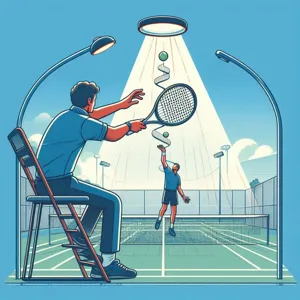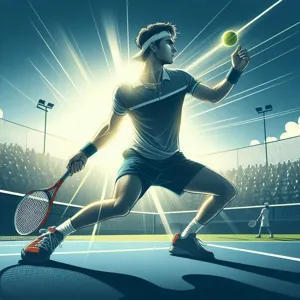In the fast-paced world of tennis, the overhead shot can often be the defining moment of a match, transforming pressure into opportunity and putting you in control of the game.
Mastering this powerful stroke not only requires technique but also a keen understanding of timing, positioning, and strategy. Whether you’re a seasoned player looking to refine your skills or a beginner aiming to elevate your game, perfecting your overhead returns can significantly improve your overall performance on the court. In this blog post, we will explore the top drills designed to enhance your overhead technique, boost your confidence, and sharpen your competitive edge. From footwork exercises to practice routines that simulate match scenarios, we’ll guide you through a comprehensive approach to mastering the overhead shot, ensuring you’ll be ready to dominate your next match with precision and style.
1. Understanding the Importance of the Overhead in Tennis

The overhead shot is often regarded as one of the most pivotal strokes in tennis, yet it is frequently overshadowed by more glamorous techniques like the serve or the forehand. However, mastering the overhead can dramatically elevate your game and transform the way you handle high balls, especially those that come from your opponent’s lobs. Understanding its importance is the first step toward perfecting this essential skill.
At its core, the overhead is not just about brute strength; it’s about timing, precision, and strategic positioning. When executed correctly, it allows you to take control of the point by transitioning from defense to offense in a matter of seconds. The overhead can be a powerful weapon, capable of finishing points decisively and demoralizing your opponent. Imagine a perfectly timed overhead smash that leaves your rival scrambling, or a well-placed shot that lands just out of reach. This level of control can shift the momentum of a match in your favor.
Moreover, the overhead is a crucial response to your opponent’s attempts to exploit your positioning on the court, particularly during net play or when you’re drawn wide. By mastering the overhead, you not only improve your ability to counter these scenarios but also enhance your overall court awareness. You learn to read your opponent’s intentions and react accordingly, making your game more dynamic and unpredictable.
Incorporating overhead drills into your practice routine can lead to significant improvements in footwork, hand-eye coordination, and shot accuracy. These drills help build muscle memory and confidence, allowing you to execute the overhead instinctively during matches. Ultimately, understanding the importance of the overhead in tennis is about recognizing its potential to not just defend, but to dominate. By honing this skill, you empower yourself to take charge of the game, keeping your opponents on their toes and ensuring that you remain a formidable presence on the court.
2. Key Mechanics of a Successful Overhead Shot
Mastering the overhead shot in tennis is crucial for turning the tide of a match, especially when facing a well-placed lob. Understanding the key mechanics behind a successful overhead not only enhances your performance but also builds your confidence on the court.
First and foremost, positioning is everything. As soon as you detect an opponent’s lob, sprint towards the ball, positioning yourself directly underneath it. Your feet should be shoulder-width apart, providing a solid base for balance and power. Use small, quick steps to adjust your position, and keep your eyes locked on the ball as it descends.
Next comes the grip. Many players opt for the continental grip for overheads, as it allows for versatility and effective contact with the ball. As you prepare to strike, raise your racket above your head, ensuring that the strings face upwards. This is your opportunity to engage your core and legs—generate momentum by pushing off the ground and using your legs to add power to your shot.
When it’s time to make contact, focus on your swing. A smooth, fluid motion is key. As you swing down and through the ball, aim to hit it at the highest point possible. Your follow-through should extend naturally, with your racket finishing high, which not only ensures that your shot is powerful but also directs it accurately over the net.
Finally, practice makes perfect. Incorporate drills that focus on these mechanics, such as shadow swings or targeting exercises with a partner. Remember, each overhead shot presents a unique scenario, so being adaptable and confident in your technique will serve you well in competitive play. Mastering these key mechanics will not only elevate your game but also make you a formidable opponent on the court.
3. Essential Footwork for Positioning and Balance

In tennis, the difference between winning and losing a point often boils down to your footwork. Mastering the essential footwork for positioning and balance can significantly enhance your ability to return serves effectively. Good footwork allows you to get into the optimal position to strike the ball, ensuring that your return is not only powerful but also precise.
First and foremost, understanding the split-step is crucial. This foundational move involves a quick hop just as your opponent makes contact with the ball, allowing you to react promptly to the direction of the serve. This split-step should be light and explosive, enabling you to spring into action, whether you need to move laterally or toward the net.
Once you’ve executed the split-step, focus on maintaining a low center of gravity. Bend your knees slightly and keep your feet shoulder-width apart. This stance will help you balance and prepare for quick lateral movements. As you anticipate the ball, practice shifting your weight from one foot to the other, allowing your body to remain agile and ready to pivot in any direction.
Moreover, mastering diagonal movement is essential during a return. As the serve comes toward you, use small, quick steps to navigate your way into the optimal hitting zone. Think about positioning your body so that you can strike the ball in your comfort zone—ideally at waist height, where you can execute both topspin and slice returns effectively.
Lastly, never underestimate the power of practice. Set up drills that emphasize footwork patterns, such as ladder drills or cone exercises, to improve your agility and quickness on the court. Incorporating these drills into your training routine will not only enhance your footwork but also contribute to your overall stability and balance during those critical return moments.
By honing your footwork skills, you’ll find yourself better equipped to handle a variety of serve types, making your returns more consistent and effective. Remember, in tennis, it’s not just about hitting the ball hard; it’s about hitting it smartly and accurately, and that starts with great footwork.
4. Drill 1: The One-Handed Overhead Drill
### Drill 1: The One-Handed Overhead Drill
The one-handed overhead is a quintessential stroke in tennis, combining power and precision to turn the tide of a match in your favor. To master this technique, it’s essential to focus on developing the right posture, timing, and follow-through. This drill is designed to hone your skills through repetition, ensuring that when the moment arises on the court, you can execute your overhead with confidence and finesse.
**Setting Up the Drill**
Begin by finding a partner or a ball machine to help you practice. If you’re using a partner, have them feed balls to you from the baseline, or if you’re using a ball machine, set it to deliver high balls that simulate an opponent’s lob. Position yourself a few feet behind the baseline to give yourself ample space to move and react.
**Execution**
As the ball approaches, adopt an athletic stance with your feet shoulder-width apart. Pivot on your back foot and rotate your shoulders to position yourself correctly. As you track the ball, extend your non-dominant arm forward to help with balance and sighting the incoming shot. When the ball is at its highest point, bring your racket up with a smooth, fluid motion. Aim to hit the ball at the peak of its arc, using your wrist to snap through the shot for added power.
Focus on your follow-through, ensuring that your racket finishes high above your shoulder. This not only adds effectiveness to your shot but also prepares you for your next move. Repeat this drill multiple times, alternating between forehand and backhand positions to develop ambidexterity and adaptability.
**Tips for Improvement**
As you become more comfortable with the stroke, experiment with varying your position on the court. Practice moving forward, sideways, and even backward to simulate real-game scenarios where you might need to make an overhead return under pressure. Additionally, consider incorporating feedback from your partner or recording your practice sessions to identify areas for improvement.
By consistently working on the one-handed overhead drill, you’ll build muscle memory and confidence, transforming this stroke from a potential weakness into a formidable weapon in your tennis arsenal. Soon, you’ll not only master the overhead but also gain the ability to anticipate and react to opponents’ lobs with finesse and precision.
5. Drill 2: The Two-Handed Overhead Drill

### 5. Drill 2: The Two-Handed Overhead Drill
The two-handed overhead is a powerful weapon in any tennis player’s arsenal, providing stability and control while allowing you to generate impressive power. Mastering this technique can significantly elevate your game, making it essential to practice through dedicated drills. This drill focuses on improving your hand-eye coordination, footwork, and timing—all crucial elements for executing a flawless two-handed overhead.
To set up the drill, find a partner or a wall that you can rally with. Begin by standing a few feet behind the baseline, ensuring you have ample space to move. Your partner (or you, if using a wall) should feed balls to your forehand side, simulating a scenario where you need to respond to a high ball. As the ball approaches, position yourself with your feet shoulder-width apart and bend your knees slightly to maintain a low center of gravity.
As the ball rises, track its trajectory, and prepare to initiate your swing. With both hands on the racket, your dominant hand should grip the handle firmly while your non-dominant hand assists in guiding the racket into position. As you swing, focus on following through high above your head, aiming to make contact at the peak of the ball’s bounce. This will help you generate the most power while maintaining control.
To enhance your footwork, incorporate lateral movements into the drill. After each shot, practice shuffling back to your starting position, ensuring you’re ready for the next ball. This repetition will not only improve your overhead technique but also keep you agile on the court.
Remember to keep your eyes on the ball and maintain a relaxed grip throughout the motion. As you become more comfortable, increase the speed and intensity of your partner’s feeds, simulating match conditions. By consistently practicing the two-handed overhead drill, you’ll develop the confidence and skill necessary to dominate high balls during gameplay, transforming a once-challenging shot into a reliable point-winning tactic.
6. Drill 3: Target Practice with Overheads
### 6. Drill 3: Target Practice with Overheads
Target Practice with Overheads is an essential drill that hones both your accuracy and confidence when executing overhead shots. To set up this drill, position yourself on the court with a range of targets scattered across the opposite side. These targets can be as simple as cones, hula hoops, or even towels laid down to represent various zones. The goal is to hit your overhead shots with precision, aiming to land the ball within the confines of each target area.
Start by having a partner feed you high balls from the opposite side of the net. As the ball approaches, focus on your footwork, positioning yourself well underneath the shot. This is where your preparation begins; ensure your non-dominant hand is extended upwards for balance as you track the ball with your eyes.
Once you’re in position, execute your overhead swing with purpose, aiming for one of the designated targets. This drill not only improves your accuracy but also encourages you to think strategically about shot placement. As you become more comfortable, challenge yourself by increasing the distance of your targets or varying the speed and angle of the toss from your partner.
To add an element of competition, time yourself for a set number of successful shots hitting the targets, or take turns with a partner to see who can hit more targets in a specific timeframe. This not only keeps the drill engaging but also simulates the pressure of a real match where precision is key.
With consistent practice, you’ll notice a significant improvement in your overhead shots, allowing you to dominate the court with confidence. Remember, the ultimate aim of this drill is not just to hit the ball but to develop a keen sense of placement that will keep your opponents on their toes. So grab those targets and get ready to elevate your game!
7. Drill 4: Overhead Consistency with Live Ball Drills

Drill 4: Overhead Consistency with Live Ball Drills
When it comes to mastering your overheads, there’s nothing quite like the intensity and dynamism of live ball drills. These drills not only sharpen your technique but also build the confidence needed to execute overhead shots under pressure. In this drill, you’ll partner up with a fellow player to simulate real-match scenarios, allowing you to practice your overhead returns against live shots rather than from a stationary position.
To set up this drill, start by positioning your partner at the baseline. They will hit a variety of shots, including deep groundstrokes and lobs, that will challenge your ability to anticipate and react swiftly. The aim is to focus on consistency: as the ball approaches, you want to ensure your footwork is precise, your stance is balanced, and your racket positioning is optimal.
Begin with a few warm-up exchanges to get comfortable, then instruct your partner to mix in lobs at regular intervals. As the ball ascends, track its trajectory, and prepare to move into position. Visualize the shot you want to make—whether it’s a powerful smash or a controlled placement into the opposite court.
Encourage your partner to vary the height and angle of their lobs, which will help you adapt your technique in real-time. After each round, take the time to evaluate your performance: Were you quick enough? Did you maintain your composure? Were your overheads consistent?
Consider setting a specific goal for each session, such as making ten successful overhead returns in a row. This will not only keep you focused but also give you a tangible measure of your progress. Over time, this drill will not only improve your overhead consistency but also enhance your overall court awareness and reaction time, ensuring that you’re well-prepared for any overhead opportunities that come your way during matches.
8. Drill 5: Reaction Time Training for Overheads
### 8. Drill 5: Reaction Time Training for Overheads
One of the most critical aspects of executing a successful overhead return is your reaction time. The ability to quickly interpret the trajectory of the ball and respond accordingly can be the difference between a powerful smash and a missed opportunity. This drill is designed to sharpen your reflexes and improve your overhead returns under pressure.
**Setup:**
Find a partner or a hitting wall to practice with. If you’re working with a partner, have them stand at the net with a basket of balls. If using a wall, stand about 10-15 feet away, where your overhead shots can bounce back toward you.
**Drill Steps:**
1. **Warm-Up:**
Start with some light stretching to loosen up your shoulders and arms. A quick volley session will help you get into the rhythm before diving into overheads.
2. **Ball Toss Practice:**
Your partner should toss balls high into the air, varying the angle and height. As the ball approaches its peak, focus on your footwork to position yourself optimally beneath the ball. This initial practice helps you gauge the throw’s trajectory and prepares your body for the overhead swing.
3. **Reaction Training:**
After you’ve warmed up with tosses, switch to reaction drills. Your partner should randomly feed balls to you—some high and some low—forcing you to react quickly. Start with a slower feed and gradually increase the speed as you grow more comfortable.
4. **Targeted Overheads:**
Now, add a target to the mix. Place cones or markers in various zones of the court. As your partner feeds you the ball, aim to direct your overhead shots toward these targets. This adds an element of precision to your drill and mimics real-game scenarios where placement is crucial.
5. **Vary the Pace:**
After a few rounds, have your partner mix in some unexpected shots, such as underhand serves or quick volleys, to simulate different match situations. This dynamic element will keep you on your toes and enhance your adaptability on the court.
6. **Cool Down:**
finish with some light stretching to prevent injury and allow your muscles to recover. Reflect on your performance and identify areas for improvement.
**Tip:** Consider incorporating a stopwatch to time your reaction intervals, aiming to reduce your response time with each session. Over time, you’ll find that not only will your reaction time improve, but your confidence in executing overheads will soar, making you a formidable opponent on the court.
By consistently engaging in this reaction time training, you’ll develop a quicker, more instinctive response to high balls, transforming your overhead returns into a powerful weapon in your tennis arsenal.
9. Incorporating Overheads into Match Play Scenarios
Incorporating overheads into match play scenarios is a crucial step in mastering this vital shot. Understanding how to effectively execute an overhead during live play can mean the difference between winning and losing crucial points. To practice this, simulate match conditions where you can add pressure and unpredictability to your drills.
Begin by partnering with a fellow player and taking turns lobbing the ball over the net. Start with a moderate pace and gradually increase the intensity. As your partner sends you lobs, focus on your footwork, positioning, and timing. Remember, the key to a successful overhead is not only in the execution but also in your ability to read the trajectory of the ball. Make sure to anticipate the lob and move swiftly into position to maximize your reach.
Next, introduce specific match scenarios into your practice. For example, imagine you’re down a set point or facing a challenging opponent—this mental aspect will help simulate the adrenaline and pressure of an actual match. Practice hitting overheads from both the baseline and the service line, as this will help you adapt to various situations you might face during a game.
Additionally, consider using video analysis to observe your form and technique. Recording your practice sessions allows you to spot areas for improvement, like your swing path or follow-through, and make adjustments accordingly.
Finally, don’t forget to incorporate a variety of spins and angles into your overheads during practice. A well-placed, topspin-heavy overhead can force your opponent out of position, while a slice can keep them guessing. By diversifying your shots and honing your overhead skills, you’ll not only enhance your game but also build the confidence needed to execute this crucial shot under pressure. With consistent practice and a strategic approach, you’ll find yourself turning potential points into winners, solidifying your position as a formidable player on the court.
10. Mental Techniques for Overcoming Overhead Anxiety
When it comes to mastering the overhead shot in tennis, physical prowess is only part of the equation. Often overlooked, mental fortitude plays a crucial role in transforming a good player into a great one. Overhead anxiety can creep in, causing hesitation and uncertainty at critical moments. To conquer this mental hurdle, it’s essential to develop specific techniques that bolster your confidence and focus.
One effective method is visualization. Before stepping onto the court, take a moment to picture yourself executing the perfect overhead shot. Envision the ball soaring over the net, landing precisely in the opponent’s court. By rehearsing these successful outcomes in your mind, you’re training your brain to expect success, which can significantly reduce anxiety when the real game begins.
Another powerful technique is mindfulness. Practicing mindfulness helps you stay present and minimizes the distractions that often accompany high-pressure situations. Focus on your breath, grounding yourself in the moment. This can help you detach from negative thoughts or fears about missing the shot, allowing you to embrace the action with renewed clarity and focus.
Additionally, adopting a positive self-talk strategy can bolster your mental game. Replace self-doubt with affirmations like, “I am a skilled player, and I can handle this shot.” Regularly reminding yourself of your capabilities can shift your mindset from one of fear to one of empowerment.
Finally, consider incorporating pre-match routines that calm your nerves and set a positive tone for the game. Whether it’s listening to your favorite music, meditating, or engaging in light stretching, these rituals can create a sense of familiarity and comfort, making the pressure of overhead shots feel less daunting.
By implementing these mental techniques, you can effectively overcome overhead anxiety, turning a potential point of weakness into one of your greatest strengths on the court. Remember, tennis is as much a mental game as it is a physical one—master your mind, and you’ll master your overhead.
11. Common Mistakes and How to Avoid Them
When it comes to perfecting your tennis returns, avoiding common mistakes can be the difference between a successful rally and a missed opportunity. Here are some pitfalls players often encounter and strategies to sidestep them.
**1. Poor Footwork**
One of the most prevalent mistakes is neglecting footwork. Many players tend to stand flat-footed, waiting for the ball to come to them. This not only limits your range of motion but also affects your timing and balance when making contact. To avoid this, practice your lateral and diagonal movements during drills, ensuring that you’re always in an optimal position to return the ball. Utilize agility ladders or cone drills to enhance your foot speed and positioning.
**2. Excessive Tension**
Another common error is gripping the racket too tightly, which can lead to a stiff and unyielding swing. This tension often results in mishits and a lack of control. To combat this, focus on relaxing your grip and allowing your wrist to be more fluid during your swing. Practicing with a lighter racket or doing shadow swings without a ball can help you develop a more relaxed grip.
**3. Lack of Follow-Through**
A frequent oversight is failing to complete the follow-through after striking the ball. Many players cut their swing short, which can lead to inconsistent returns and a loss of power. Ensure that your follow-through is smooth and deliberate; visualize your racket continuing in the direction of your target even after contact. Drills that emphasize full swings, such as hitting against a wall or using a ball machine, can reinforce this habit.
**4. Ignoring Spin**
Some players underestimate the importance of spin when returning serves. Not adjusting to the type of spin can lead to unforced errors. Familiarize yourself with the different types of spins, such as topspin, backspin, and sidespin. Incorporate drills that help you recognize and adapt to spin during practice matches, allowing you to react more effectively in real game situations.
**5. Failing to Read the Server**
Lastly, many players overlook the significance of reading the server’s body language and racket angle. This can provide valuable clues about the type of serve being delivered. Sharpen your observational skills by watching your opponent’s stance and swing patterns during warm-ups. During matches, try to anticipate the serve based on these cues, allowing you to position yourself better and react more quickly.
By identifying these common mistakes and implementing strategies to avoid them, you can enhance your return game and become a more formidable opponent on the court. Remember, consistency and practice are key, so dedicate time to these aspects to elevate your overall performance.
12. Using Video Analysis to Improve Your Overhead Technique
In the quest to master your overhead technique, one of the most powerful tools at your disposal is video analysis. This method transcends traditional coaching; it allows you to visually dissect your performance, identify weaknesses, and track your progress over time. By recording your practice sessions or matches, you can gain invaluable insights into your body mechanics, footwork, and overall execution of the shot.
Start by setting up a camera or mobile device at a strategic angle that captures your full swing. Once you’ve recorded your overheads, take the time to review the footage with a critical eye. Look for key elements: Are you positioning yourself correctly beneath the ball? Is your racquet face angled properly for maximum control? Pay attention to your follow-through—does it provide the necessary power and placement?
Moreover, comparing your technique to that of professional players can be incredibly enlightening. Analyze slow-motion clips of top athletes performing overheads. Observe their footwork, grip, and timing, and try to incorporate some of their techniques into your own game. This side-by-side comparison can highlight specific areas where you can improve, making it easier to set actionable goals.
Finally, don’t hesitate to share your analysis with a coach or a more experienced player. Their feedback, combined with your visual insights, can help refine your technique even further. By harnessing the power of video analysis, you can take your overhead game to new heights, ensuring that when the moment comes to put away that high ball, you’ll do so with precision and confidence.
13. Strength and Conditioning for Overhead Performance
To truly master your overhead shots, it’s essential to complement your technical skills with a solid foundation of strength and conditioning. The overhead is not just about timing and precision; it requires a robust combination of upper body strength, core stability, and leg power. By focusing on these areas, you can significantly enhance your overhead performance, ensuring that you not only execute the shot effectively but also maintain your balance and agility on the court.
**Upper Body Strength**: The overhead involves powerful movements driven by your shoulders, arms, and wrists. Incorporate exercises such as shoulder presses, tricep dips, and resistance band pulls into your routine. These will help you develop the strength needed to generate explosive power as you strike the ball.
**Core Stability**: A strong core is crucial for maintaining balance and transferring energy effectively from your lower body to your upper body during an overhead shot. Engage in planks, Russian twists, and medicine ball throws to build a solid core. Not only will this improve your shot accuracy, but it will also reduce the risk of injury.
**Leg Power**: Your legs play a vital role in positioning and generating force for your overheads. Plyometric exercises like box jumps, lunges, and squat jumps can enhance your leg strength and explosiveness. These drills will help you achieve better court coverage and allow you to jump higher, giving you the advantage of a better angle on your overheads.
**Endurance Training**: Lastly, don’t overlook the importance of cardiovascular fitness. Including aerobic exercises, such as running or cycling, in your training regimen will boost your stamina. This is particularly important in long matches where fatigue can impact your performance.
By integrating a well-rounded strength and conditioning program into your training, you can elevate your overhead game from merely effective to formidable. The results will be evident not just in your shot power and accuracy but also in your overall performance on the court, allowing you to dominate your opponents with confidence.
14. Tips from the Pros: Insights from Top Players
When it comes to mastering the overhead in tennis, there’s no shortage of wisdom from the sport’s elite. Top players have honed their skills through years of practice, and their insights can be invaluable for anyone looking to elevate their game. One common thread among professionals is the emphasis on footwork. Rafael Nadal, known for his incredible agility, often stresses the importance of getting into position quickly. “Good footwork allows you to set up for the shot properly,” he says, highlighting how a solid foundation is crucial for executing powerful overheads.
Serena Williams, a powerhouse on the court, takes a slightly different approach. She advocates for the mental aspect of the game, urging players to visualize the overhead before executing it. “See it in your mind, and then make it reality,” she advises. This mental visualization can help you anticipate the ball’s trajectory and position your body accordingly, leading to a more confident and effective overhead shot.
Additionally, Roger Federer emphasizes the importance of practicing with purpose. He recommends drills that simulate match conditions, allowing players to practice their overheads under pressure. “The key is to create scenarios where you need to react quickly and decisively,” he notes. Incorporating game-like situations into your training can prepare you for the unpredictable nature of actual matches.
Lastly, Venus Williams shares a vital tip on maintaining composure when facing high balls. She suggests taking a deep breath and focusing on your target rather than the incoming ball. “Stay calm and trust your instincts,” she says, reminding players that confidence is just as important as technique.
By implementing these pro tips into your training regimen, you can refine your overhead technique and transform it into one of your most potent weapons on the court. Remember, the journey to mastering the overhead is not just about physical practice; it’s also about cultivating the right mindset and approach to the game.
15. Creating a Personalized Practice Routine for Overheads
Creating a personalized practice routine for overheads is a crucial step in mastering this powerful shot. Unlike general drills that may focus on a variety of strokes, tailoring your overhead practice allows you to hone in on your specific strengths and weaknesses, ultimately making your game more effective and dynamic.
Start by assessing your current overhead skills. Are you comfortable with the basic mechanics, or do you struggle with footwork and positioning? Taking a moment to reflect on these aspects will guide you in designing a routine that addresses your individual needs. For instance, if you find yourself often misjudging the ball’s trajectory, consider incorporating drills that focus heavily on timing and ball tracking. Practice swinging at varying heights and distances to improve your adaptability on the court.
Next, establish a structured schedule that combines repetition with variety. Dedicate specific days to different drills: one day for shadow swings to perfect your form, another for live-ball drills where you can practice overheads in real match situations. Incorporating drills like the “overhead volley-to-smash” sequence can also help you transition smoothly between shots, building muscle memory that can be invaluable during a match.
Don’t forget to include fitness elements in your routine. Incorporate agility and footwork drills, such as ladder drills or cone sprints, to enhance your movement on the court. A strong overhead is not just about the swing; it’s about getting into position quickly and efficiently.
Finally, consider tracking your progress. Keep a journal or use a mobile app to log your practice sessions, noting what worked well and what needs improvement. This reflective practice will not only help you stay motivated but will also allow you to adapt your routine as you evolve as a player. By creating a personalized practice routine for your overheads, you’ll not only develop consistency but also gain the confidence to unleash this potent weapon during crucial moments in your matches.
In conclusion, mastering the overhead is a vital skill that can elevate your tennis game to new heights, allowing you to seize control of the match and outmaneuver your opponents. By incorporating the top drills outlined in this post into your practice routine, you’ll develop the confidence and precision needed to execute powerful returns consistently. Whether you’re a beginner aiming to build a solid foundation or an advanced player looking to refine your technique, these drills will help you harness the full potential of your overhead shots. So grab your racket, hit the court, and watch as your improved returns transform your gameplay, turning challenging situations into opportunities for victory. Happy practicing, and may your overheads always find the sweet spot!




